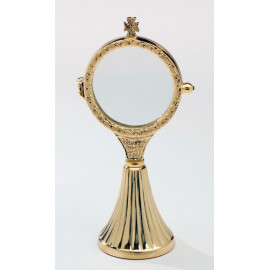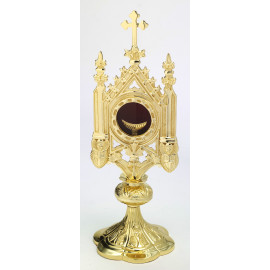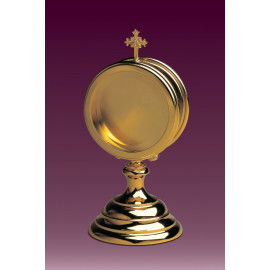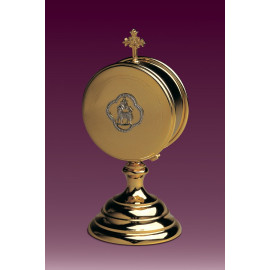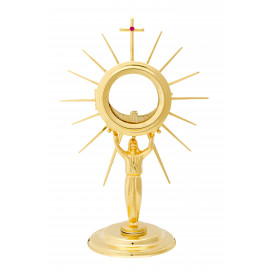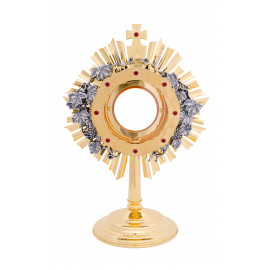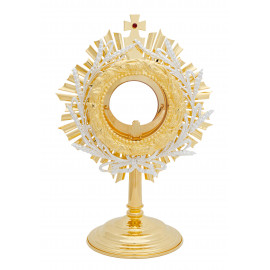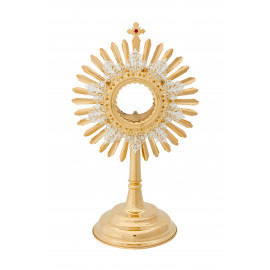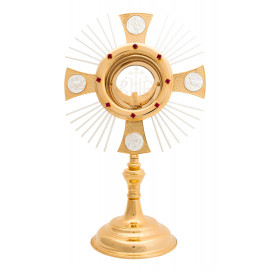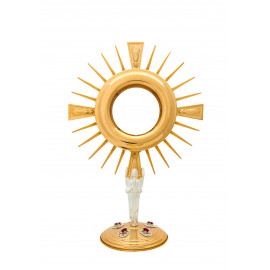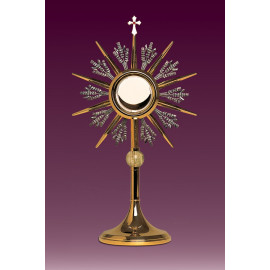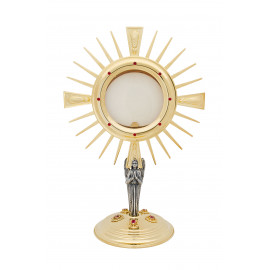No products
Product successfully added to your shopping cart
There are 0 items in your cart. There is 1 item in your cart.
Monstrances
- Altar Bell and Gong
- Candle Snuffer
- Candlestick
- Catholic Pyx
- Chalices
- Church wall lamps
- Ciborium
- Crosses and Crucifix
- Cruets & Trays
- Holy Water Font
- Holy Water Pot
- Missal Stand
- Monstrance Tabor
- Monstrances
- Offering Baskets
- Oil Stock
- Patens
- Reliquaries
- Sanctuary Bells
- Sanctuary Lamp
- Sprinkler
- Thurible, Boat, & Spoon
- Travel Liturgy & Mass Kit
A monstrance, also known as an ostensorium, is a liturgical vessel used in Roman Catholic, Old Catholic, High Church Lutheran, and Anglican churches to display the consecrated Eucharistic host during Eucharistic Adoration. The monstrance is typically made of silver-gilt or other precious metal and highly decorated. It usually has a small round glass in the center of the sunburst, through which the Blessed Sacrament can be seen. Behind this glass is a round container made of glass and gilded metal, called a lunette, which holds the host securely in place. The monstrance can take many forms, but most today use the popular and recognizable shape of a sunburst atop a stem with a wider base. The Great Monstrance of the Cathedral of Toledo is one of the largest in the world, more than twelve feet high, and adorned with two hundred and sixty statuettes. The monstrance plays an important part in Eucharistic Adoration because it houses the consecrated Eucharist host where Jesus’ presence dwells, giving Catholics the opportunity to enter the presence of Jesus and adore the Eucharist fully and without distraction.
A monstrance, also known as an ostensorium, is a liturgical vessel used in Roman Catholic, Old Catholic, High Church Lutheran, and Anglican churches to display the consecrated Eucharistic host during Eucharistic Adoration. The monstrance is typically made of silver-gilt or other precious metal and highly decorated. It usually has a small round glass in the center of the sunburst, through which the Blessed Sacrament can be seen. Behind this glass is a round container made of glass and gilded metal, called a lunette, which holds the host securely in place. The monstrance can take many forms, but most today use the popular and recognizable shape of a sunburst atop a stem with a wider base. The Great Monstrance of the Cathedral of Toledo is one of the largest in the world, more than twelve feet high, and adorned with two hundred and sixty statuettes. The monstrance plays an important part in Eucharistic Adoration because it houses the consecrated Eucharist host where Jesus’ presence dwells, giving Catholics the opportunity to enter the presence of Jesus and adore the Eucharist fully and without distraction.
Monstrances There are 12 products.
Unveiling the Mystique of the Church Monstrance
The church monstrance, a vessel of profound significance in Catholic and Anglican traditions, stands as a beacon of divine presence and a focal point of Eucharistic adoration.
Let's dive into the fascinating world of the monstrance, exploring its history, design, and the pivotal role it plays in religious devotion.
The Origins and Evolution of the Monstrance
The term "monstrance" is derived from the Latin word "monstrare," meaning "to show."
This is fitting, as the primary purpose of a monstrance is to display the consecrated Eucharistic host, allowing the faithful to engage in adoration of the real presence of Jesus Christ.
Initially, the monstrance took shape in the 14th century, evolving from vessels like pyxes and reliquaries used to transport and display sacred relics.
Over time, the design of the monstrance has undergone significant transformations, reflecting changes in artistic styles and theological emphasis.
The Artistic Majesty of Monstrances
Monstrances are renowned for their elaborate and intricate designs, often crafted from precious metals and adorned with jewels.
The most common design features a sunburst pattern, symbolizing the radiance of the divine, with a central glass pane through which the Eucharist is visible.
This design serves a liturgical function and stands as a testament to the craftsmanship and artistic heritage of the Church.
The Monstrance in Liturgical Practice
The use of the monstrance is most closely associated with the practice of Eucharistic adoration and the Benediction of the Blessed Sacrament.
During these devotions, the monstrance is placed upon the altar, making the Eucharist visible to the congregation for prayer and meditation.
This act of exposition and adoration underscores the Catholic belief in the real presence of Christ in the Eucharist, inviting the faithful into a more profound relationship with the divine.
FAQs: Unraveling Common Queries
What materials are monstrances made from?
Monstrances are typically crafted from precious metals such as gold or silver, often embellished with gems and intricate designs to reflect their sacred purpose.
Can anyone handle a monstrance?
Due to its sacred nature, the monstrance is usually handled only by clergy during liturgical ceremonies. When moving the monstrance, priests often use a humeral veil to show reverence.
Are monstrances used outside the Catholic Church?
Yes, monstrances are also used in the Anglican and Old Catholic traditions for similar purposes of Eucharistic adoration and devotion.
How are monstrances stored when not in use?
When not in use, monstrances are typically stored in a secure, respectful place within the church, such as a sacristy or a dedicated tabernacle.
The Monstrance: A Symbol of Faith and Devotion
The church monstrance is more than just an object of religious art; it is a profound symbol of faith, a focal point for devotion, and a tangible connection to the divine presence in the Eucharist.
Through its history, design, and use in liturgical practice, the monstrance invites the faithful to contemplate the mystery of the real presence and to deepen their relationship with Christ.
In the glow of the monstrance, believers find a source of spiritual nourishment, a beacon of hope, and a reminder of the boundless love at the heart of the Christian faith.

